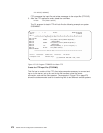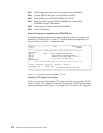
Chapter 8. File Transfer Protocol (FTP) Server
The File Transfer Protocol (FTP) server function allows you to send or receive
copies of files to or from server systems across a TCP/IP network. In addition, the
FTP server provides functions for renaming, adding, and deleting files.
You can access FTP server functions via a command line interface or the
Operations Navigator (graphical user interface). Not all FTP functions are available
on both interfaces.
This chapter discusses how you start and stop the FTP server via the command
line interface and through Operations Navigator. This chapter does not document
any of the other Operations Navigator functions. This chapter deals primarily with
command line interface functions. See the on-line Help for Operations Navigator for
information about using the Operations Navigator for FTP functions.
Also, note that even though some of the functionality of the command line interface
and the Operations Navigator is the same, the actual menu commands and
parameters are not necessarily the same.
More File Transfer Protocol (FTP) Server documentation material is covered in the
AS/400e Information Center under the TCP/IP topic. For more information see
“TCP/IP Topics in the Information Center” on page xv.
FTP Server-What It Does and Does Not Support
The following sections provide a brief description of the functions of the FTP server,
and some details of its limitations.
Functions Supported by AS/400 FTP Server
v Exit points to enable “Anonymous” FTP and FTP security controls (see “File
Transfer Protocol (FTP) Exit Points” on page 553).
v Transferring files in the “root,” QOpenSys, QLANSrv file, and QFileSvr.400
systems.
v Transferring folders and documents in the document library services (QDLS) file
system.
v Coded character set identifier (CCSID) support
v Creating and deleting libraries, files, and members using the AS/400 FTP server
subcommands.
v Creating and deleting folders using the AS/400 FTP server subcommands.
v Sending or receiving save files and members in physical files, logical files,
Distributed Data Management (DDM) files, and source physical files.
v Sending text files in EBCDIC format or converting them to ASCII (the default
format).
v Transferring binary files as is.
v Using the current library. The TCP/IP FTP server uses the current library
specified in the AS/400 user profile. If no library is specified in the user profile, or
if an error occurs, the QGPL library is used as the current library.
© Copyright IBM Corp. 1997, 1999 279


















